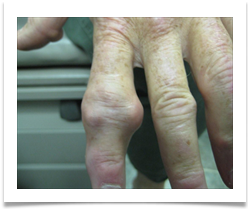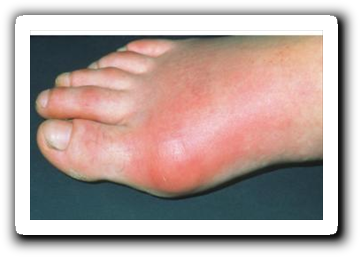Gout Print Page
Overview
The sudden onset of pain in the big toe. It’s red, it’s hot, it’s swollen.
This is the typical presentation for gout. However, gout can affect any joint similarly. Gout is caused by the immune system’s reaction to uric acid deposition in the joints. Gout is affects approximately 4% of people, making it the most common form of inflammatory arthritis. This number is higher in males and increases with age. A number of medical conditions and medications can also predispose you to gout. If left untreated, gout flares can become more frequent, severe, affect more joints, or begin to affect other organs.
Fortunately, there are a number of treatment options available to treat gout flares, including colchicine, anti-inflammatories, and cortisone injections. For those with more frequent flares, there are preventative medications such as allopurinol available too.
Frequently Asked Questions
What is Gout?
- Gout is a type of arthritis caused by the presence of too much uric acid crystals.
 Why does Gout happen?
Why does Gout happen?
- Uric acid crystals trigger a response from the immune system. This response is what causes gout flares. In fact, even between flares, there still are uric acid crystals which can be found in the joint.
Who gets Gout?
- Gout affects 4% of the population, and increases with age and uric acid levels. Overall, gout is more common in men than women. It is extremely uncommon for a pre-menopausal female to have gout.
What are the symptoms in Gout?
- Gout starts suddenly, most often in only one joint, but it can affect a few a time. Most patients describe the joint as very painful, red, hot, and swollen. On average, a gout attack lasts 5 days.
Which joints are commonly involved?
- The classic and most common joint is the base of the big toe. However, any joint including other toes, ankles, knees, wrists, and hands all can be involved.
 What increases the risk of developing gout?
What increases the risk of developing gout?
- There are a number of potential risks, including:
- Family history
- Age
- Male Gender
- Excessive weight
- Other chronic conditions (E.g. Kidney disease, hypothyroidism, infections, etc)
- Post-surgery
- Certain medications (E.g. diuretics, low dose aspirin)
- Alcohol
I have heard certain food can increase your risk for gout.
- Uric acid is broken down in the body from purines. While the body produces purine on its own, they are also found in a higher quantity in certain foods, including meats, seafoods, and some vegetables (E.g. asparagus, cauliflower, spinach, beans, peas, mushrooms, etc.)
- Some patients know they will have a gout flare after they eat a specific food, although this is not the case for most.
- It is not advisable to follow a purine free diet for the sole purpose of trying to prevent gout. If you did, it would likely not lower your uric acid levels enough to significantly improve your gout. More importantly, your overall diet would become quite poor and unhealthy.
How do you diagnose Gout?
- Gout can usually be diagnosed through your medical history and physical exam findings. A definitive diagnosis is made by taking a sample of inflamed fluid from the involved joint to analyze for uric acid crystals.
Is there a blood test which can confirm the diagnosis?
- Uric acid levels in the blood are commonly checked to help diagnose gout. However, this is in no way definitive. In fact, uric acid levels can decrease during a gout flare, meaning if it was tested, it could appear normal and you might make the mistake of dismissing the diagnosis. The best test is to analyze the joint fluid.
How about x-rays?
- If left untreated, gout can cause damage to the bone in and around the affected joints. This is more often found in advanced cases.
Can gout affect more than just joints?
- Chronically elevated levels of uric acid not only deposit in joints, but can deposit elsewhere in the body. These aggregates of uric acid crystals, called tophi, are white nodular chalky deposits which can be found in or near joints, extensor surfaces such as the elbows, back of the heel, or even the ears. They typically develop over a period greater than 10 years.
How do you treat Gout?
- There a number of different medications which treat the acute gout flare. One is not necessarily better than the other, but may be more appropriate for certain patients because of co-existing medical problems. Remember, these treatments only help with the flare; they do not affect uric acid levels. Options include:
- Anti-inflammatories (NSAIDs) – The classic NSAID used is Indomethicin, but any NSAID can be effective. NSAIDs are not a good option for patients with heartburn or stomach ulcers, and kidney problems.
- Colchicine – A common choice without the above problems. However, it needs to be taken at the first sign of a gout flare to be most effective and can sometimes cause diarrhea. It should never be used more than three times a day.
- Cortisone injection directly into the joint – A very effective choice which treats gout locally, but requires quick access to a physician.
I am having a lot of flares. Is there a way to prevent gout flares?
- Yes. While the above treatments help with flares, treatment aimed at lowering uric acid levels is can be taken to prevent the frequency and severity of flares, as well as other complications. The most common medication for gout flares is allopurinol, although there are a number of others than may be suggested by your doctor.
How is allopurinol taken?
- Allopurinol is a once a day pill. While the most common dose is 300mg per day, it is critical to choose the right dose that effectively lowers your blood uric acid levels. It will not work if it does not effectively lower your uric acid levels. Allopurinol should not be stopped or started during a flare. Both these actions can actually worsen the flare.
Are there any natural treatments that have been proven to be helpful?
- There is growing evidence that Vitamin C may provide a small benefit in preventing gout.
- Dairy products appear to lower the risk of gout.
I was told I have pseudo-Gout. Is that the same thing?
- While pseudo-gout can look the same as gout, it is caused by calcium pyrophosphate crystals, not uric acid. While the treatment for a flare is similar, there is no preventative medication like allopurinol.
What is the prognosis for gout?
- Most patients do quite well with gout if treated. If left untreated, gouty tophi can begin to appear. Further, high uric acid levels can be associated with an increased risk for kidney stones and kidney damage. Research is currently looking at the association between uric acid levels and heart disease.